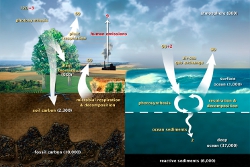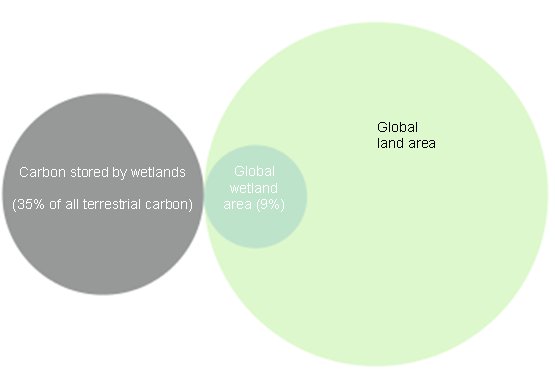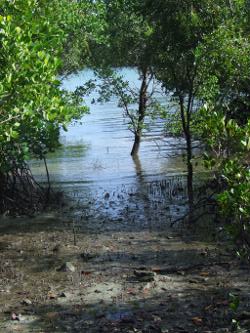|
|
Wetlands and the carbon cycleWetlands are one of the most carbon-dense ecosystems on Earth[4]. They have high productivity and exchange large quantities of carbon with the atmosphere and terrestrial, freshwater, and marine ecosystems through regular flooding[8]. The role of wetlands in capturing and storing carbon is often underestimated. Globally, wetlands are estimated to store over a third of the world’s terrestrial carbon with blue carbon being one of the most important stores in Australia. Their destruction often results in major releases of greenhouse gases to the atmosphere. However, their role in the carbon cycle isn’t simple or easy to generalise. Quick facts
Wetlands play a dynamic and crucial role in absorbing atmospheric carbon[7][2][6]. According to the Ramsar Scientific and Technical Review Panel, wetlands cover just 9% of the planet’s land surface, yet are estimated to store 35% of terrestrial carbon. Generally, undisturbed, or intact wetlands tend to act as ‘carbon sinks’ due to their dense vegetation, algal activity and soils. They regulate processes such as anaerobic decomposition which generates methane and nitrous oxide. These gases respectively have 21 and 310 times more global warming impact than carbon dioxide over a 100 year timeframe[5][9]. However, the capacity of intact wetlands to absorb and sequester carbon varies widely depending on the type of wetland, temperature and water availability[6][2][3]. Research continues to better understand and identify the processes involved, and how these processes will be affected by climate change. As wetlands generally act as carbon sinks, their drainage and destruction can result in substantial carbon emissions[9]. Taking water out of a wetland means oxygen can reach previously inundated organic matter. This results in large emissions of carbon dioxide as the organic matter oxidises. Thus, the degradation of Queensland’s wetlands, especially melaleuca wetlands and mangroves, contributes to overall greenhouse gas emissions[3]. Of particular concern is the drainage and disturbance of potential acid sulphate soils, many of which underlay wetlands. When exposed to air these soils release large amounts of greenhouse gas emissions[5]. Australia’s wetlands are atypical due to the country’s dryness and climate variability. Coastal wetlands, especially tidal marshes, mangroves and seagrass are considered to have the greatest potential as carbon sinks in Australia. It has been estimated that every hectare of mangrove wetland stores about 550t of carbon. Restoring and protecting wetlands presents an important opportunity for mitigating greenhouse gas emissions[9]. Globally, there is significant work underway to develop methodologies for restoring and managing wetlands that will support the generation of carbon credits. Australia has a Blue Carbon accounting model (BlueCAM)under the Commonwealth Government’s Carbon Farming Initiative. Research supported by Queensland Government as part of the Land Restoration Fund and conducted by Deakin University’s Blue Carbon Lab has modelled blue carbon soil stocks for seagrass and mangroves in Great Barrier Reef Catchments. Additional links
References
Last updated: 10 September 2020 This page should be cited as: Department of Environment, Science and Innovation, Queensland (2020) Wetlands and the carbon cycle, WetlandInfo website, accessed 8 May 2025. Available at: https://wetlandinfo.des.qld.gov.au/wetlands/ecology/processes-systems/carbon-cycle/wetlands-carbon-cycle/ |

 — Department of the Environment, Tourism, Science and Innovation
— Department of the Environment, Tourism, Science and Innovation




